Speech Five Years of Financial Crisis

Luci Ellis
Head of Financial Stability Department
Address to the CPA Australia Finance and Accounting Expo 2012
Sydney –
- Audio 21.59MB
It's a pleasure to be back at this conference. Thank you once again for the kind invitation. When I last spoke to this group two years ago, I noted that it had been three years since interbank markets became disrupted. Already then we had seen after-effects in places like Greece that had nothing to do with the origins of the crisis. So we've been coping with some level of financial crisis and distress for five years now.
What I'd like to do today is take a step back and consider the beginnings of the crisis. I would like to discuss why neither its genesis nor its propagation to the global financial system were anticipated and why it was not prevented. And I'd like to set out some of the lessons to take from this crisis, including some mistaken conclusions that should not be taken on board.
The Beginning
Before the crisis, global financial conditions could be best described as ‘too good to be true’, and we knew it. Looking back at the Financial Stability Reviews we published in 2006 and early 2007, and indeed those from foreign agencies, it is clear that we knew all was not well.[1] Investors were accepting very low prices for taking on risk (Graph 1). Credit growth was very strong in a number of countries.
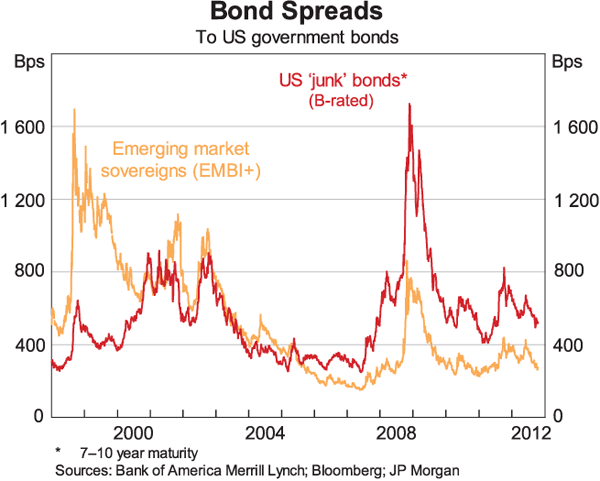
Prior to August 2007, there were some early shudders – false starts, if you like – that caught many people's attention. We saw the wobble of an exchange rate here, the collapse of a hedge fund there. I remember sitting in meetings at the BIS in early 2007 talking about some of these events. The question on everyone's lips was: is this the Big One?
So a lot of people in policy circles and elsewhere were alert to the vulnerabilities in the system. Lots of people knew that there was a chance something could go seriously wrong. But nobody, no matter what they claim now, really anticipated quite how it would play out.
The Meltdown
A lot of people were aware that the risks in the US mortgage market had risen. But few realised that it had reached the point that it was no longer a housing boom of the kinds we had seen before. Some people were aware that lending standards had eased, but few appreciated just how far things had gone in the United States. I know I didn't at the time. I wrote a paper in 2006 pointing out that not all housing booms result in macroeconomic busts, though they can also worsen downturns that happen for other reasons (Ellis 2006).[2] That conclusion remains true: not all booms end in crisis, even though the US one did. And it was a pretty good prediction for the countries I actually mentioned in the relevant passage – Australia, the UK and the Netherlands. But it would have been a terrible forecast for outcomes in the United States, a country I wasn't referring to in that section. Foreign observers like the RBA didn't realise how overstretched the US housing market had become, because there simply wasn't the data to show that lending standards had eased more in the US than elsewhere. The US authorities and most other observers in the United States largely missed it too. They weren't routinely comparing their situation with other countries and didn't see how exceptional it had become.
To be sure, some private sector commentators were concerned about the US housing bubble. But the metrics they cited, such as the ratios of housing prices to incomes or rents, would not have told you that the US housing market was in a more vulnerable position than those of other countries. Prices and debt actually rose less in the United States than in several other countries where booms ended much less painfully. The poor lending practices that created so many bad loans in the United States simply weren't sufficiently visible in the usual data. Most of the activity was in new, non-bank lenders that didn't attract much scrutiny from regulators. And some banks didn't even seem to recognise that they were easing up on lending standards. You can see in this graph that bank senior loan officers knew that they were tightening standards in 2007 and 2008, but they didn't report much easing before that (Graph 2). They didn't see it as easing; in their eyes, they were just responding to competition.
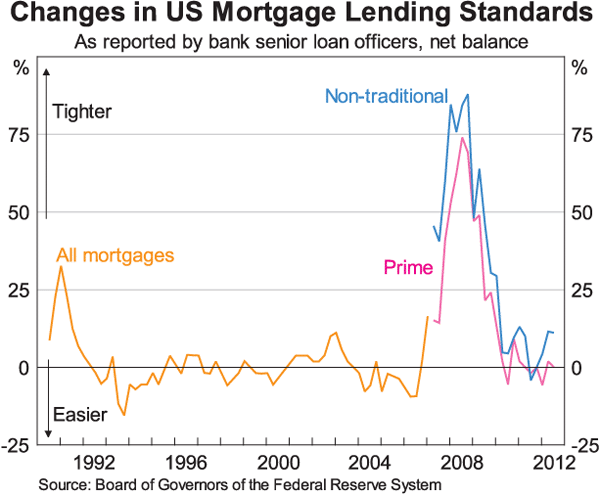
Housing prices had only fallen around 5 per cent in the US by mid 2007, but already this was enough to put several lenders out of business. Because they securitised their loans, they didn't think they needed to absorb losses and they had no balance sheet to do so: they were volume businesses. But when the loan went bad so quickly that it obviously should never have been granted, contractually the investors in the resulting mortgage-backed security could ‘put back’ the loan to the originator. There were a shockingly large number of these early defaults.
Property busts, especially commercial property but sometimes also housing, often spark domestic banking crises. If the US had had a banking crisis all on its own, perhaps that crisis could have been dealt with differently. But this crisis went global, and it was this connection between US mortgage markets and the global system that wasn't well understood, and that essentially nobody predicted. How did that happen? First, some of the central actors in the US mortgage finance boom were a few dozen global banks, heavily interconnected with global banks headquartered elsewhere. Second, the securities backed by these mortgages were in some cases bought by foreign banks or their affiliates. So instead of sweeping the risk out of the banking system, securitisation spread some of the losses through the banking system.
A third factor that helped turn this local housing bust into a global panic was that the resulting securities were long-term assets, but they were funded by very short-term funding. Maturity transformation – borrowing short and lending long – is a normal function of the banking system. It is also an important reason why banking institutions have to be prudentially regulated.[3] They have to hold capital and some liquid assets to avert a run, and they have to be able to access central bank liquidity in the event of a general panic.
But in the US the banking system wasn't the main provider of mortgage credit. The loans were packaged up into securities, often passed from bank to bank in a complex production chain before landing in the balance sheet of an ultimate investor or investment vehicle. Often the investment vehicles were funded very short term: investors were using these vehicles for transactional purposes like funding their payroll, expecting the funds to be liquid without a proper liquidity backstop (Pozsar et al 2010). One thing that policymakers didn't expect is that the professional investors in these kinds of funds were even more flighty and prone to run than retail depositors.
As I mentioned, there were only a few dozen institutions involved in running the securitisation machine. There were, however, many more ultimate investors in the final securities. Often they did not understand the risks in those securities. The structures were quite opaque, and the language describing the underlying mortgages – subprime, Alt-A, HELOC[4] and so on – did not give a good sense of the quality of those loans. The same label was applied to loans that performed very differently, depending on who made the loan and where the home was.
As the mortgage losses piled up, the prices of these securities fell. The firms and investment vehicles that held those securities began to incur losses. The consequences of this were another thing that policymakers didn't anticipate. Not only did they not appreciate how exposed the major global banks, and some minor ones, were to these bad assets. They also didn't appreciate how much everyone would panic because they didn't know which of their counterparties were exposed to those bad assets, and how far the prices of the securities would decline. Banks became unwilling to lend to each other on an unsecured basis, and the price of such lending rose drastically (Graph 3).
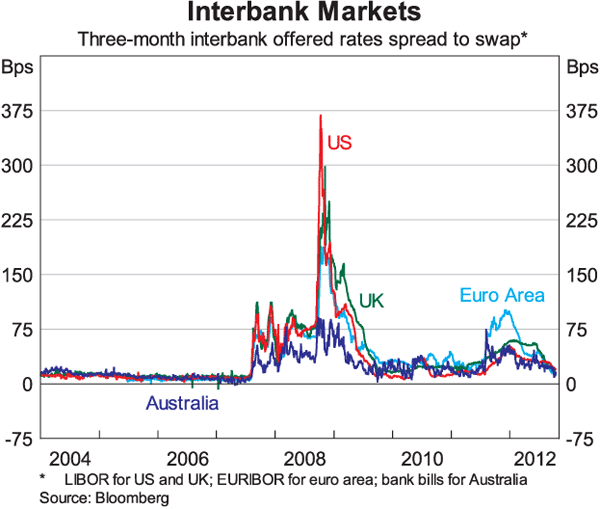
Securitisation was meant to be this wonderful thing that got risk out of the banking system, but actually it just moved it to other parts of the banking system, out of sight of the US regulators, and apparently out of mind of banks' management.
Since I am speaking to an audience of accountants, I should also mention the role that valuation practices played in the crisis. Because these securities were so opaque, investors were unusually uncertain about how they should be priced. Sometimes they just relied on the credit rating, which creates its own problems. Sometimes they relied on the pricing models of the bank that sold them the securities, which raised all sorts of governance issues. But even if they did their own valuations, marking to model became all but infeasible. It wasn't enough just to disclose what kinds of mortgages were behind the security, because the marketing labels didn't reveal enough about loan quality. There was subprime and subprime. The level of detail about the lending standards mattered enormously, and so did the details of the valuation models based on that information.
The Subsequent Convulsions
After the panic following the failure of AIG, Lehman and others, it wasn't long before the macro data took a turn for the worse. The global economy headed for a serious downturn: the contraction in the G7 economies was unlike anything seen in decades (Graph 4).
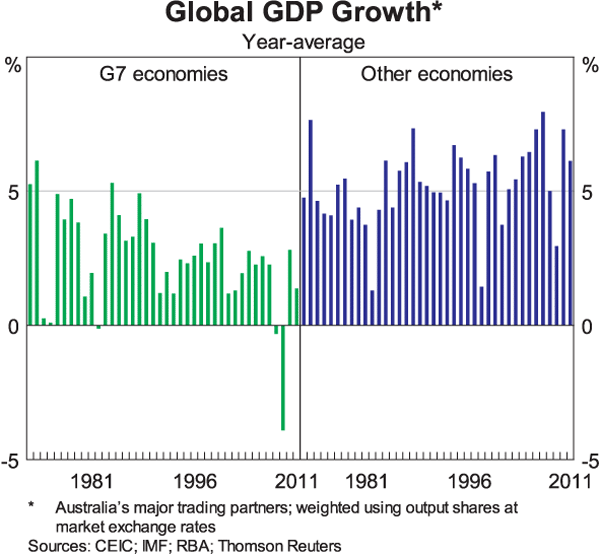
Why did economic activity contract so quickly, and in so many countries quite removed from the financial centres where the trouble began? I don't think there is yet a definitive answer to this question. There are several plausible possibilities but two in particular come to mind. First, there was a big news effect. Remember it wasn't just Lehman that failed in those critical weeks. There had been a cascade of failures, especially in the United States. There was a real sense that the global financial system was at risk of collapse. It's understandable that many households and firms saw that news, and decided to rein in their spending to protect themselves better from a coming downturn. In doing so, they helped create that downturn. Keynes' ‘animal spirits’ remain highly relevant to macroeconomic outcomes, even now.
Second, reinforcing that effect, some recent empirical work has shown that a few large organisations can have disproportionate effects on economic activity – firm-specific effects don't just wash out in the aggregate (Gabaix 2011). For example, this research cites evidence that 35 per cent of Korean exports are accounted for by just two firms, and only 10 or so firms account for the same fraction of Japanese exports. With that in mind, it isn't hard to imagine how these large reactions occurred in apparently distant countries. If both those Korean firms changed their production plans because of concerns stemming from the crisis, of course we would see a large effect in the macroeconomic data. In that light, perhaps the sharp declines in real output can be more easily understood, even if they seemed shocking at the time (Graph 5).
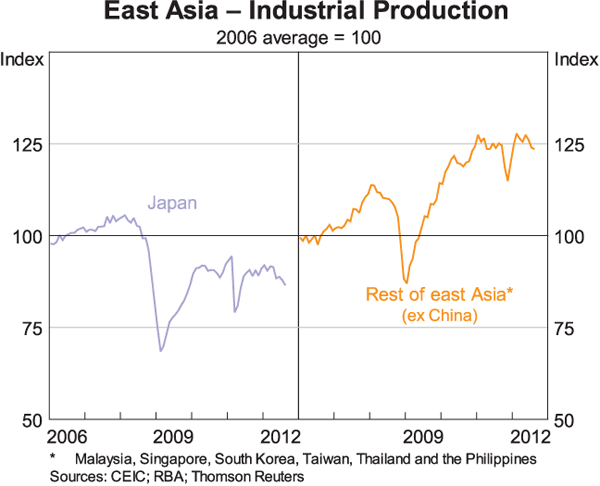
And as economies turned down and risk aversion rose, we started to see the effects on parts of the world that were apparently unconnected to the original crisis. Business models that seemed to work when credit was easy started looking less sensible. We are seeing that especially clearly in Europe recently. But there have been several other waves of turmoil in between, in places like Dubai and eastern Europe.
The Lessons
The last five years have taught a number of lessons to policymakers, market participants and outside observers such as academics. But have we learned the right lessons?
We learned that short-term wholesale funding markets can be even flightier than supposedly unsophisticated depositors. So banks needed to change their funding mix, and in Australia at least, they have. But the firms overseas that got into trouble because of their funding models tended to have much higher shares of wholesale funding, and shorter maturities, than we see in Australia today. It would be a mistake to conclude that any level of wholesale funding is dangerous.
We should also bear in mind that some of the metrics people use to assess funding structures can be quite misleading. I am thinking particularly of the loan-to-deposit ratio. This ratio is higher in Australia than it is in some other banking systems, though not out of line with a few others (Graph 6). But if you see a bank with a very low level of this ratio, well below 100 per cent, ask yourself what the bank is doing with that deposit funding instead. They are investing it in securities and other kinds of investment. And as we saw in the crisis, those securities can often be far riskier than regular lending. So it would be a mistake to focus on these kinds of metrics.
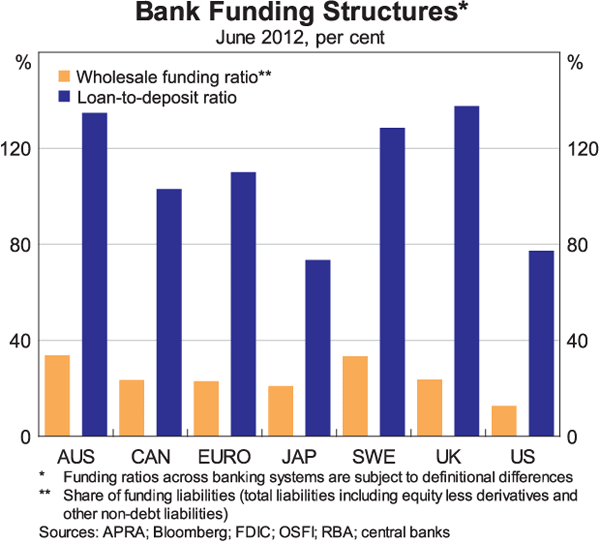
We also had yet another iteration of the old lesson that property market dynamics can drive episodes of financial instability. Ten years ago, the global debate about whether monetary policy should respond to asset prices was rather unhelpfully focused on equity markets, which at the time did not have the kind of leverage that is the nub of the problem. The crisis has shown that property markets are usually more relevant to financial stability. These markets have the boom–bust dynamics and leverage needed to turn an asset price downturn into a financial crisis. But it would be a mistake to conclude that the biggest – or indeed the only – risk to financial stability stems from home mortgage lending. Quite frankly I consider it irresponsible to fixate on one source of risk to the exclusion of others that are more relevant or pressing. Let me be clear: risks from housing markets are not zero, and never will be. But commercial real estate or property developers are still more likely to pose risks to a financial system, and through it, to the real economy. The longer history of financial crises all over the world has taught us that. And there are other risks within the financial system itself that are at least as worthy of attention. Any sensible policy for promoting financial stability monitors all reasonable potential risks, and responds proportionately according to their relative importance.
It would likewise be a mistake to conclude that just because housing markets in some countries have caused problems, they always will, in all countries. The US market is quite unusual. Housing booms have to end sometime, but they don't have to end in tears. Among other things it takes the passage of time and diligent attention from the regulators to ensure housing booms don't end in a harmful bust, but it can be done.
We learned that the major banking systems of the world needed more capital, and that the capital needed to be real, loss-absorbing capital. That is why the Basel III package was so crucial. But it would be a mistake to think that the answer to every problem is more capital. I can well imagine a situation where bank management and regulators become complacent about highly capitalised banks. They might think their bank can't possibly burn through all that capital and fail. Just like ‘that ship couldn't possibly sink’.
If the same bank gets more capital but changes nothing else, it will be safer. There will be more shareholders' funds to absorb any losses that might occur. But all else is not equal. The bank with more capital might feel emboldened to try to grow faster, or to take on other risks. Or it might be being required to hold that extra capital, because it has a business model that is inherently riskier in ways the Basel risk weights don't capture properly. For example, its business might be quite geographically concentrated. The Basel framework already handles cases like this using what is known as Pillar 2. Supervisors can and do require banks to hold more capital to cover these kind of bank-specific risks. In Australia, APRA routinely sets some institutions' Prudential Capital Ratios to be higher than the Basel minimum. Business models differ, and thus so do inherent risks. Because of that, I wouldn't necessarily expect a bank with higher capital to be safer than one with lower capital. It might or might not be. It depends on whether the additional capital was enough to cover these less easily measured risks.
So we should not be surprised that banks with high reported capital ratios were not less likely to fail than banks with lower capital ratios. Part of the problem is that the rules differ slightly across countries, even under Basel II. More broadly, though, this is an example of the well-known trope that ‘you become what you measure’. If you tell people to fulfil a particular metric, they will do so. But in doing so, the metric will start to lose its relationship with the thing you really care about. For this reason, I doubt that we will ever find the single variable that would ensure financial stability if only banks could be made to meet it. This is why diligent supervision is, if anything, more important than how simple or complex or clever the rules might be.
Finally, there was a further lesson reinforcing our existing view that the pursuit of financial stability requires thinking holistically. The people who knew that the US mortgage market had become imprudent didn't know how the resulting credit risk was being distributed globally. The people who understood structured finance didn't know much about housing and mortgage markets. The system was too complex and interconnected for one person to be expert in all its elements and links. In fact we should not expect any system to be entirely within a single person's expertise. This is why interagency cooperation – and international cooperation and information sharing – is so important.
To conclude, five years on we are still in a world where risk aversion is high and some parts of the financial system seem dysfunctional. In some countries – though not Australia, I believe – the supply of credit is tighter than the underlying risks would require. I hope I won't come back in five years' time to deliver a speech titled ‘Ten Years of Financial Crisis’. But I do think that the experience of the past five years has affected a whole generation of financial market participants and policymakers. We will never be able to regulate the financial boom-bust dynamic away entirely. There will always be people with the risk appetite and the incentives to become over-exuberant. It would not surprise me, though, if the next five or ten years see a lot less of that over-exuberance than we saw in the five or ten years leading up to 2007. The challenge will be to be ready to respond when those memories fade and the next generation of the overconfident are gearing up for a party.
Thank you for your time.
Endnotes
I particularly have in mind the second paragraph from the Overview of the September 2006 Financial Stability Review, which pointed out that valuations were based on favourable expectations and susceptible to disappointing news. The APRA Annual Report for 2004/05 noted concerns that risk was being underpriced and emphasised that business strategies should not lose touch with economic realities (p 9). [1]
The relevant discussion is on pages 29–30. It wasn't until I went to the BIS in 2007 and was working on related topics that I realised how bad things were in the US mortgage market, especially relative to other countries. [2]
In Australia, not all deposit-taking institutions are called ‘banks’; they include credit unions and building societies. All these institutions are prudentially regulated by APRA, and collectively they are known as authorised deposit-taking institutions (ADIs). I use the terms ‘banking institution’ and ‘banking system’ to mean all types of financial firm engaged in banking business, regardless of their label. [3]
HELOC stands for home equity line of credit. [4]
References
Ellis L (2006), ‘Housing and Housing Finance: The View from Australia and Beyond’, RBA Research Discussion Paper 2006-12.
Gabaix X (2011), ‘The Granular Origins of Aggregate Fluctuations’, Econometrica 79(3), pp 733–772.
Pozsar Z, T Adrian, A Ashcraft and H Boesky (2010), ‘The Shadow Banking System’, Federal Reserve Bank of New York Staff Report 458, available at <http://www.ny.frb.org/research/staff_reports/sr458.pdf>.